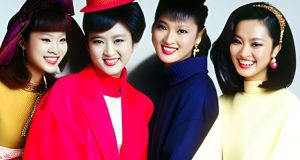The 1990s marked a turning point for the Asian fashion landscape as Asian designers and trends started to acquire popularity and influence abroad. Asian fashion designers became well-known during this time, pushing the envelope of conventional fashion and popularising fresh looks that mirrored the era’s shifting cultural milieu.
The 90s Asian fashion scene was a melting pot of styles that reflected the diversity and ingenuity of the region, ranging from daring streetwear to sophisticated evening attire. It is crucial to review and recognize the accomplishments of this legendary era because many of these styles and designers still have an impact on modern fashion. We shall examine the prevalent fashion fads and designers of the 90s Asian fashion scene in this detailed guide.
I. Popular fashion trends in the 90s Asian fashion scene
The 90s Asian fashion scene was characterized by a diverse range of fashion trends that reflected the cultural and social changes happening in the region. From streetwear to high-end couture, the era was marked by a blending of traditional Asian styles with modern Western influences. Here are some of the most popular fashion trends of the 90s Asian fashion scene:

Streetwear:
Streetwear was a popular trend in the 90s Asian fashion scene, with designers like Nigro of A Bathing Ape and Hiroshi Fujiwara of Goodenough leading the way. These designers popularized oversized graphic t-shirts, baggy pants, and sneakers, which were often paired with bold accessories and statement pieces.
Kawaii fashion:
Kawaii, meaning “cute” in Japanese, was a popular trend in the 90s Asian fashion scene, characterized by bright colors, playful patterns, and adorable accessories. Brands like Hello Kitty and Sanrio were instrumental in popularizing kawaii fashion, which was embraced by both children and adults alike.
Minimalism:
While bold and colorful styles were popular in the 90s Asian fashion scene, there was also a trend towards minimalist fashion, characterized by clean lines, neutral colors, and understated elegance. Designers like Yoji Yamamoto and Issy Miyake were at the forefront of this trend, which emphasized simplicity and sophistication.
Traditional Asian styles:
Traditional Asian styles, such as the qipao and the hanbok, also saw a resurgence in popularity during the 90s Asian fashion scene. Designers like Vivienne Tam and Alexander McQueen incorporated these traditional styles into their collections, creating a fusion of traditional and modern fashion.
Overall, the 90s Asian fashion scene was marked by a diverse range of styles, from streetwear to high-end couture, that reflected the changing cultural landscape of the region. These trends continue to influence contemporary fashion today and serve as a testament to the creativity and innovation of the designers of this iconic era.
II. Iconic Asian fashion designers of the 90s
The 90s Asian fashion scene was marked by the emergence of several iconic fashion designers who helped to shape the trends and styles of the era. These designers pushed the boundaries of traditional fashion and helped to elevate Asian fashion to a global stage. Here are some of the most notable Asian fashion designers of the 90s:
Rei Kawakubo:
Rei Kawakubo, the founder of the fashion label Comma des Garcons, was one of the most influential designers of the 90s Asian fashion scene. Her avant-garde designs challenged traditional fashion norms and helped to define the era’s deconstructed fashion trend.
Yoji Yamamoto:
Yoji Yamamoto is a Japanese fashion designer known for his minimalist and avant-garde designs. His signature style of oversized silhouettes and asymmetrical cuts was groundbreaking in the 90s Asian fashion scene and helped to define the era’s minimalist trend.
Vivienne Tam:
Vivienne Tam is a Hong Kong-based fashion designer known for her fusion of traditional Asian styles with modern Western influences. Her signature “East meets West” style was popular in the 90s Asian fashion scene and helped to elevate Asian fashion to a global stage.
Alexander McQueen:
While Alexander McQueen was not Asian, his designs were heavily influenced by Asian culture and aesthetics. His signature style of edgy, avant-garde designs with intricate details and embroidery helped to popularize traditional Asian styles in the 90s Asian fashion scene.
Issy Miyake:
Issy Miyake is a Japanese fashion designer known for his innovative use of fabrics and technology. His signature style of pleated and textured fabrics was popular in the 90s Asian fashion scene and helped to define the era’s minimalist trend.
Overall, these iconic Asian fashion designers of the 90s helped to shape the trends and styles of the era, and their influence can still be seen in contemporary fashion today. Their innovative designs and unique perspectives continue to inspire and challenge the fashion industry, making them some of the most important figures in the history of Asian fashion.
III. The impact of 90s Asian fashion trends on modern fashion
The 90s Asian fashion scene had a significant impact on modern fashion, with many of the trends and styles from that era continuing to influence designers today. Here are some of the ways in which the 90s Asian fashion trends have impacted modern fashion:
Streetwear:
Streetwear has become a global phenomenon in recent years, and many of the trends popularized by 90s Asian designers like Ingo and Hiroshi Fujiwara can still be seen in contemporary streetwear fashion. Oversized graphic t-shirts, baggy pants, and sneakers have become staples of modern streetwear, and brands like Supreme and Off-White have built their empires on these trends.
Kawaii fashion:
Kawaii fashion has also become a global trend, with the rise of the “cute” culture in Japan influencing fashion designers around the world. Brands like Moschino and Marc Jacobs have incorporated kawaii elements into their collections, and the popularity of the Hello Kitty brand continues to grow.
Minimalism:
The minimalist trend popularized by designers like Yoji Yamamoto and Issy Miyake has also had a lasting impact on modern fashion. Clean lines, neutral colors, and understated elegance continue to be popular among contemporary designers, with brands like The Row and Jill Sander leading the way.
Traditional Asian styles:
Traditional Asian styles continue to influence modern fashion, with designers like Guo Pei and Tomo Koizumi incorporating traditional elements into their collections. The qipao and the hanbok, in particular, have become popular styles among contemporary fashion designers, reflecting the growing interest in global fashion.
Overall, the 90s Asian fashion trends have had a significant impact on modern fashion, with many of the styles and trends from that era continuing to inspire and influence designers today. The creativity and innovation of the 90s Asian fashion scene have left a lasting legacy on the fashion industry, and its impact can still be felt today.
IV. Conclusion
In conclusion, the Asian fashion landscape of the 1990s was one of ingenuity, originality, and cutting-edge designs. Asian fashion was elevated to a global scale thanks to the advent of prominent designers like Rei Kawakubo, Yoji Yamamoto, Vivienne Tam, Alexander McQueen, and Issy Miyake, who had a lasting influence on the sector. Streetwear, kawaii fashion, minimalism, and traditional Asian styles are just a few of the decades-old fashion fads that still have a big impact on today’s garments. The Asian fashion scene of the 1990s was a turning point in fashion history, and its effects are still seen today. Asian fashion trends and designers from the 1990s will definitely continue to inspire as the fashion industry develops and changes.

